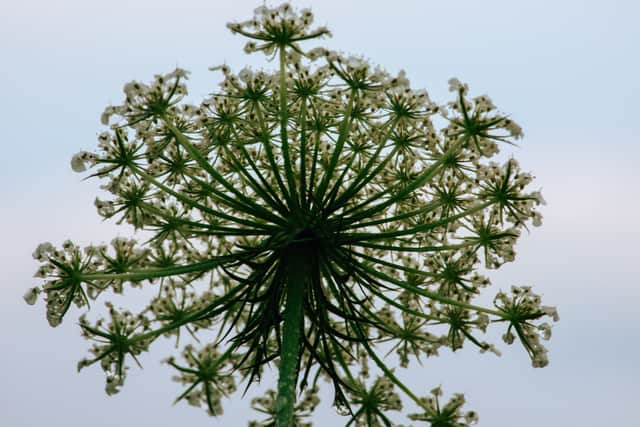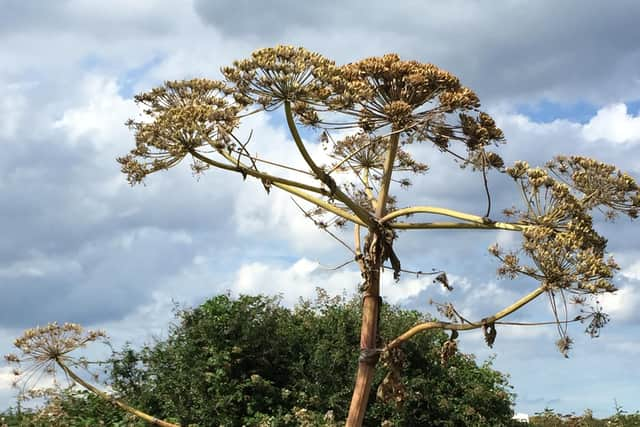Giant Hogweed: see the map of where the dangerous plant grows in Sheffield - what it looks like, how to treat
This article contains affiliate links. We may earn a small commission on items purchased through this article, but that does not affect our editorial judgement.
and live on Freeview channel 276
Giant hogweed, known to be an invasive pest that can spread at a rapid rate, has been found in many hotspot areas across Sheffield. According to an interactive map on WhatShed - an online platform for gardeners - the dangerous plant can be found across the city from Attercliffe and all the way to Oughtibridge.
According to Wild Sheffield, giant hogweed was introduced to the UK as an ornamental plant in the 19th century and quickly spread out of control. It is an invasive species commonly found along river banks, roads and railways as well as on wasteland and in gardens and allotments.
Advertisement
Hide AdAdvertisement
Hide AdJust like its cousin Japanese knotweed, giant hogweed can grow rapidly, up to heights of 10ft. And compared to Japanese knotweed, giant hogweed also has flowering leaves that are greener and more rounded than the leaves of its cousin.
While Japanese knotweed can be cut down and eaten by humans and animals due to its rhubarb taste, giant hogweed on the other hand, has a sap that can cause serious skin burns when in contact with sunlight as it is phototoxic and the blistering can even recur over the span of months, and even years.
What is Giant hogweed?
Giant Hogweed, also known by its Latin name Heracleum Mantegazzianum, originated in Southern Russia and Georgia. The plant is part of the Apiaceae family, which includes well known vegetables and herbs like parsley, carrot, parsnip and coriander.
Giant Hogweed was introduced to Britain and Europe in the 19th century, from the Caucasus Mountains. The earliest documented reference to the plant has been traced back to the Royal Botanic Gardens Kew Seed List of 1817, where seeds of the plant were listed.
Advertisement
Hide AdAdvertisement
Hide AdAccording to The Royal Horticultural Society (RHS), “most gardeners will want to eradicate it, as it is potentially invasive and the sap can cause severe skin burns”.
What does Giant hogweed look like?
Giant hogweed is often compared to another plant called cow parsley as they share similar features. Reaching up to 10 ft in height, Giant hogweed has thick, purple spotted bristly stems and large, white umbrella-like clusters of flowers.


Once in flower, giant hogweed can expel up to 50,000 seeds per plant, taking advantage of passing traffic and water flow to disperse and spread.
Giant hogweed hotspots in Sheffield
According to Whatshed, below are the Sheffield areas with the most giant hogweed infestations. You can check if your area is infested by zooming into the map.
- Nether Edge
- Endcliffe
- Worrall
- Oughtibridge
- Chapeltown
- Brightside
- Greenland
- Attercliffe
How do I treat Giant Hogweed burns?
Advertisement
Hide AdAdvertisement
Hide AdIf you accidentally get giant hogweed sap on your skin, Healthline says that you should wash the area with mild soap and cool water as quickly as possible. You should keep the skin covered when you’re outside to protect it from the sunlight.


If a rash or blister begins to form, you should seek medical attention. Your treatment will depend on how severe your reaction is. It explains: “Skin irritation that’s caught early might be treated with a steroid cream and nonsteroidal anti-inflammatory drugs, such as ibuprofen, to relieve pain. Severe burns could require surgery to graft new skin over the damaged skin.”
Healthline also explains that the Giant Hogweed sap can damage more than just your skin - if the sap gets in your eyes, you can experience either temporary or permanent blindness. Similarly, breathing in sap particles can result in respiratory problems.
Comment Guidelines
National World encourages reader discussion on our stories. User feedback, insights and back-and-forth exchanges add a rich layer of context to reporting. Please review our Community Guidelines before commenting.
